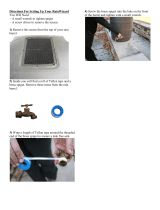18
MP5006-1001 Rev A
INTRODUCTION & SEQUENCE OF EVENTS
AUTOFILL – 3 & 6 PAN MODELS
Simple connection to water source via a garden hose style connection.
Electronic water level control for normal operation.
A master control valve
Multiple level safety controls, electronic and mechanical float.
Operates on city water supply and water pressures (40-60psi)
Easy to clean and care for.
Theory of operation
The Steamer is connected to the facility water supply via a washing machine or garden hose
type supply line from a water spigot or from a nearby sink faucet.
First time fill
1. With the water supply turned on, press the “
ON”
button. The Steamer will power up with the
pump operating.
2. The water fill valve will turn on, via the K5 relay on the water sense PCB. The status LED
on the water sensing PCB will flash rapidly about 2-3 times a second.
3. Water Fill/Sensor PCB mounted K2 relay (low water level sensing) is bypassed to allow for
first time filling of the reservoir.
4. The thermostat will be turned off, via Water Fill/Sensor PCB mounted K1 relay and CR4
bypass relay, for the first fill to prevent damage to the heater elements.
5. Water will rise to the low level probe and reset the low level circuit of the water control
board and reset relay CR4.
6. When the water level reaches the High Level Probe, a 30 second delay is initiated to
allow for wave action and rapid boiling inside to subside. Wave action and rapid boiling
would cause a lower than desired amount of water to be injected in the reservoir by
tripping the control too soon.
7. When the 30 seconds and water level have been satisfied, the water level control
board shuts off the water level control relay and the by pass relay. The status LED
will change to a slower flash rate of about 1 time per second.
8. The heater is turned on and normal operation begins.
Normal operation (the Steamer water reservoir has water in it).
1. On a full reservoir, the Steamer will heat up as normal for normal operation.
2. As the water is used up and the water level drops below the High-Level Probe, the water
valve is turned on with no delay period.
3. After the water has reached the high water level probe and stays in constant
contact, a thirty-second timing sequence is started. (This is done to prevent short
cycling of the water valve increasing the life and thereliability of the water level control
valve.)






















